Welcome to the
WalkMe Help Center
Please log in to continue

Please log in to continue

Common business workflows require employees from multiple functions and departments to follow processes that span across multiple applications. In order to make those processes more efficient and effective, organizations need to identify problem areas along that workflow.
Flow Analytics changes how organizations approach digital adoption by focusing on the business issues and outcomes at hand, allowing the ability to analyze and address friction across workflows.
By using Flow Analytics, enterprises can map, analyze, and optimize their business processes across multiple applications and multiple users. You can uncover the entire journey of users, with or without WalkMe content.
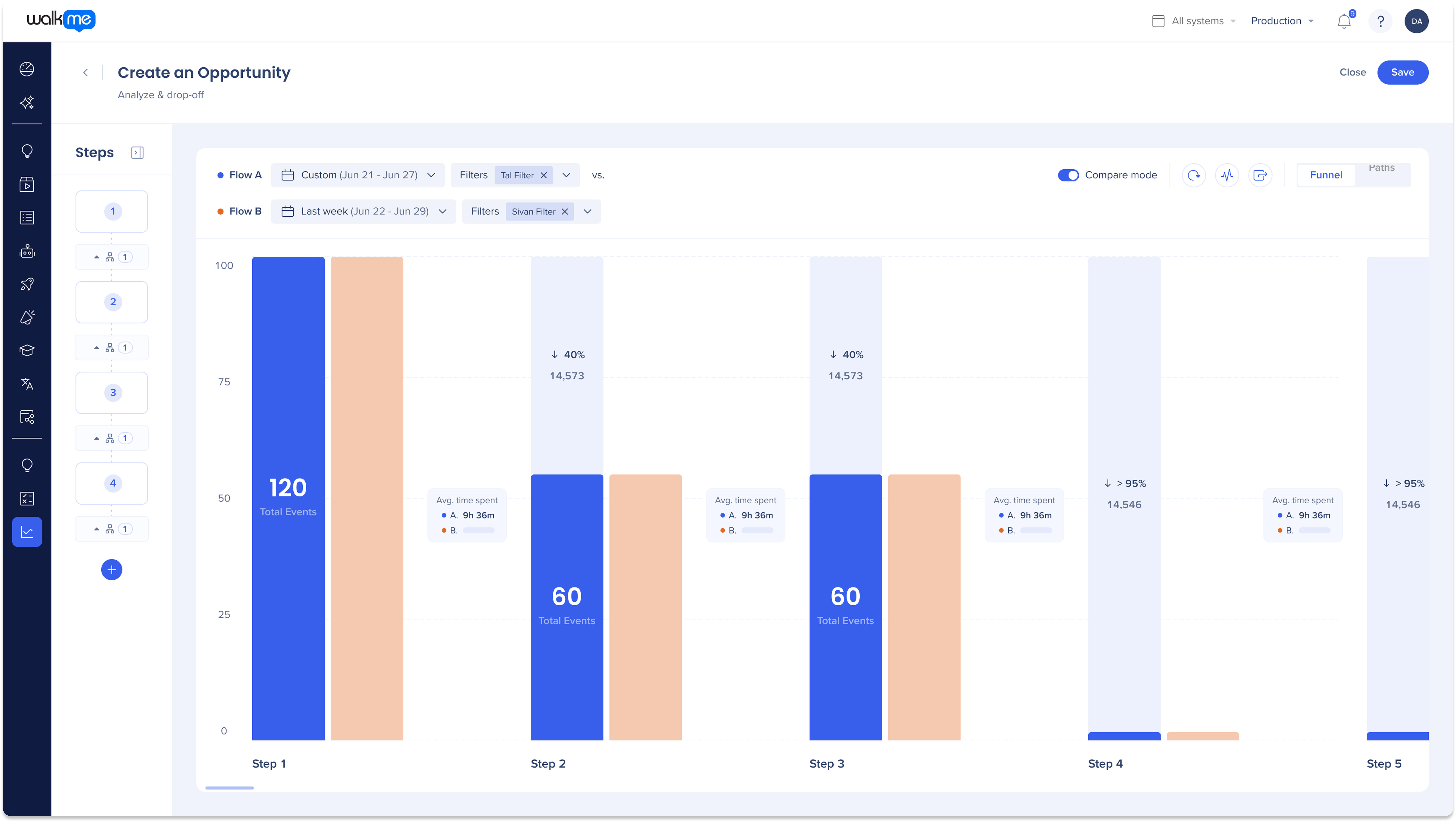
Flow Analytics is a powerful tool that allows you to visualize and optimize user journeys by tracking the progression of individual users through a series of defined steps.
Flows focus on the sequence of user actions rather than isolated events. Each step in a flow must be completed in order for the user to progress to the next step. If a user does not complete a step, they will not be recorded for subsequent steps, and no data will be shown for that user beyond the incomplete step.
This sequential tracking ensures that you can accurately identify where users may encounter obstacles in their journey, allowing you to address these issues effectively. With this understanding, you can now proceed to set up your flows, ensuring each step is clearly defined and aligned with your objectives.
Navigate to the Flow Analytics page in the console:
US Database: WalkMe Console
EU Database: WalkMe Console
Click + Create Flow
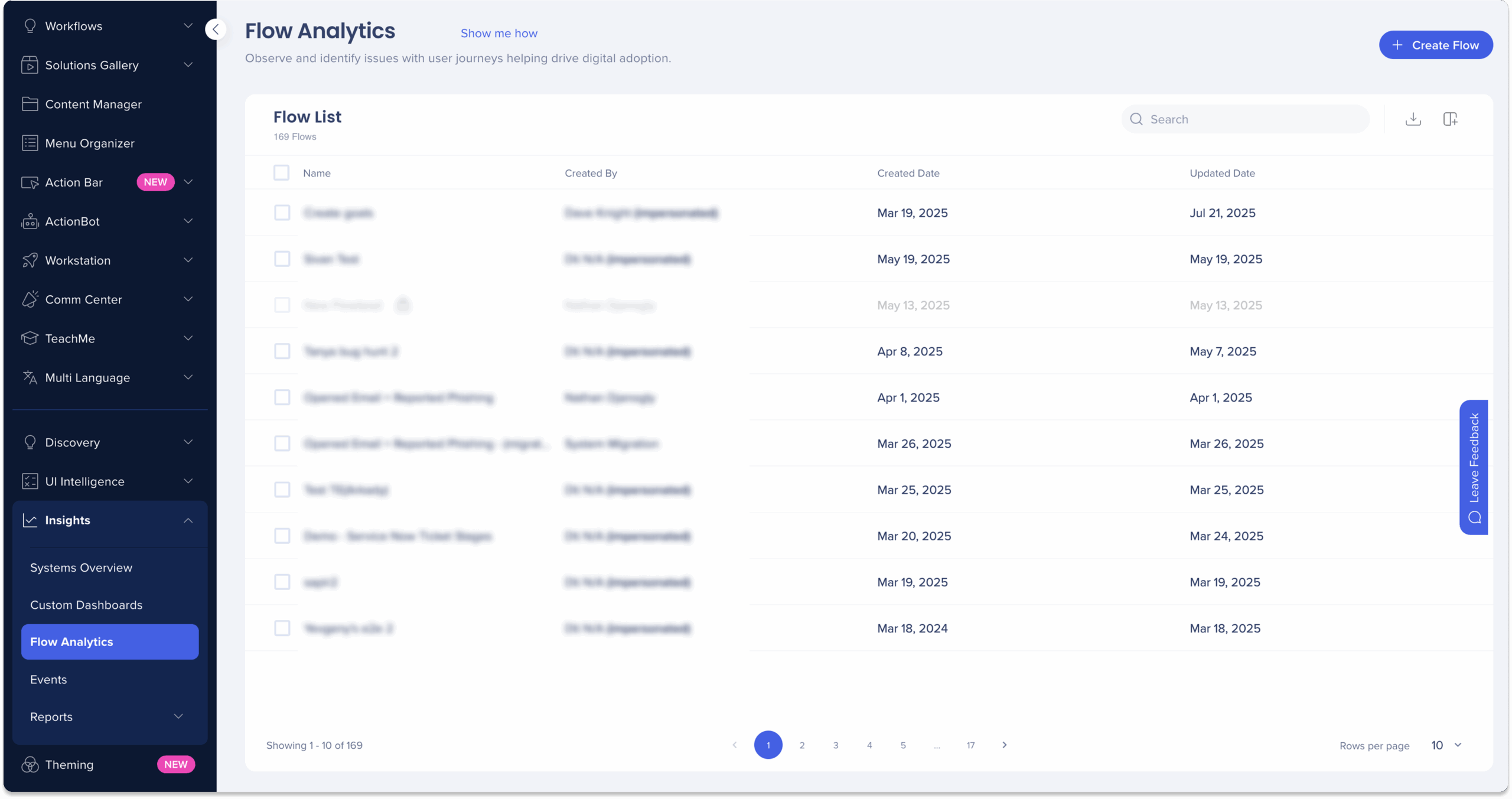
3. Choose whether you want to create a Funnel or Paths by clicking the Funnel/Paths toggle
Funnel: Analyze conversion and drop-off
Paths: Discover steps in the user journey
Enter a name and description (optional) in the top left-hand side of the page
Click the plus button + to add your first step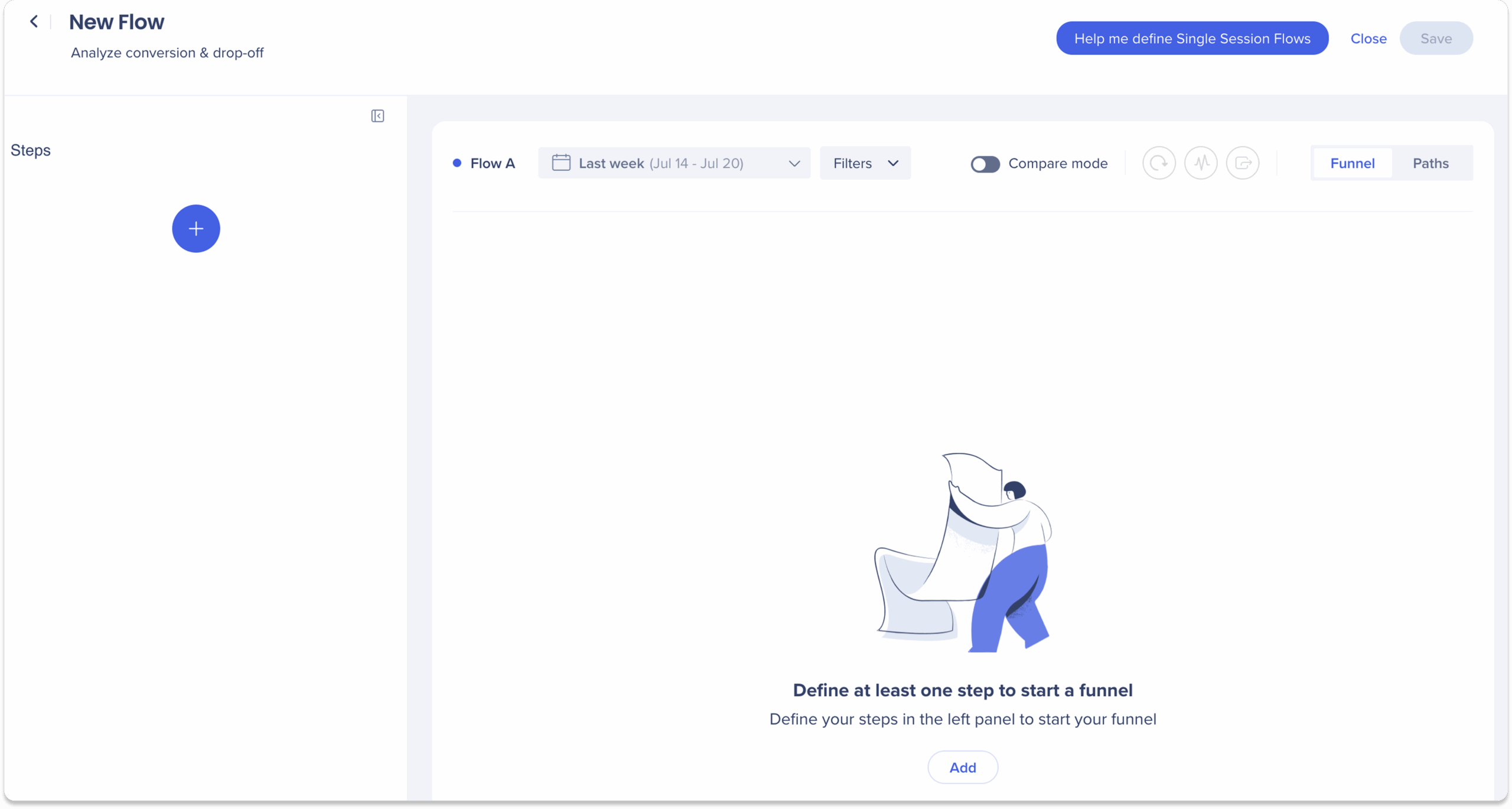
Enter a name for your step in the Untitled Step field
Select a system from the Choose System dropdown
Select an environment from the Environment dropdown
Select one of the following step definition setups:
One-Time Setup: Define a one-time setup specifically for this flow, ideal for flow steps that are not intended for reuse in Insights
Includes data on WalkMe content items or page visits
Events: Select a Tracked Event or Engaged Element from your events list
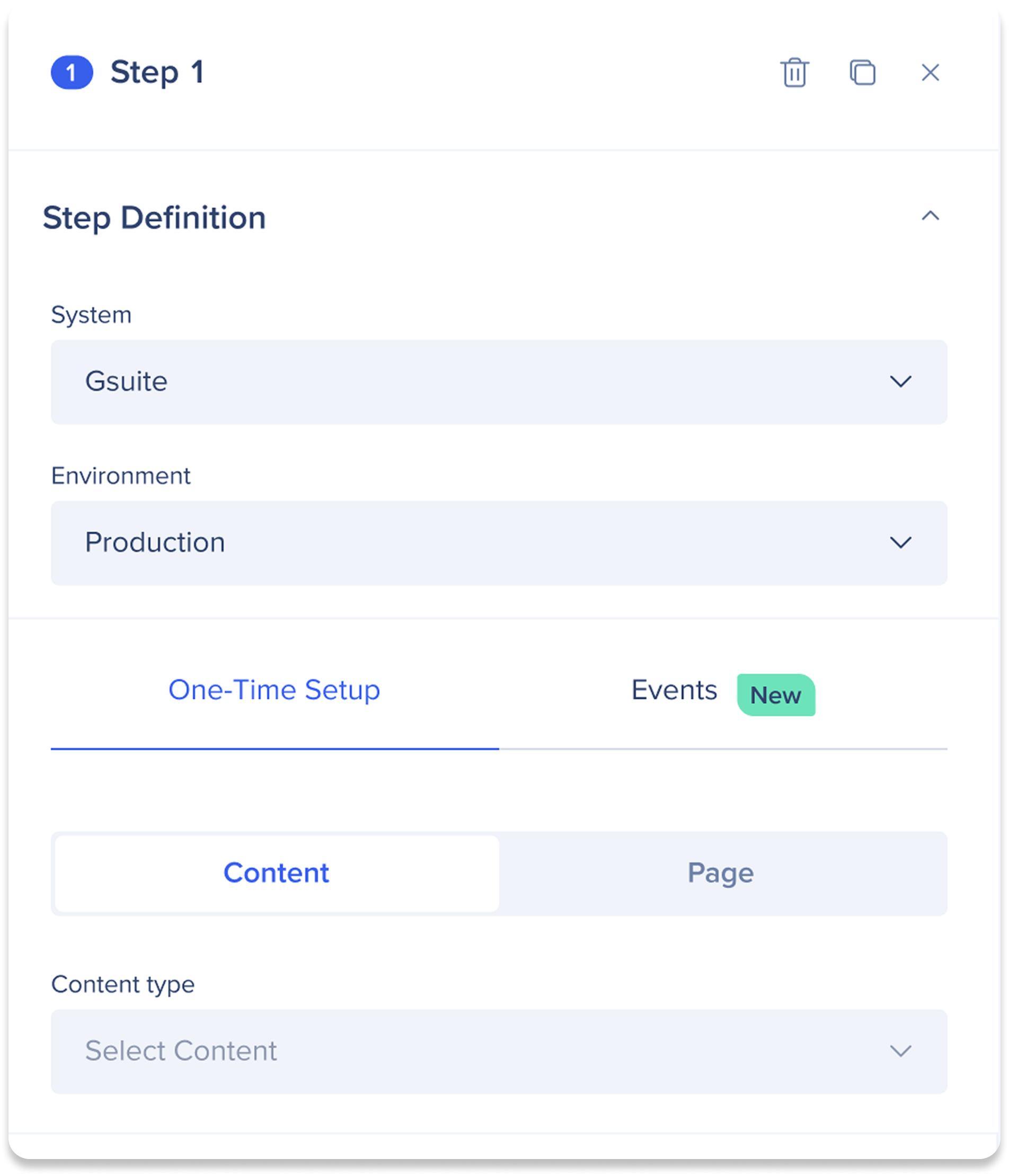
Select Content or Page to decide where the step action will occur:
Content: Existing WalkMe content (Launcher, Smart Walk-Thru, etc.)
Select the relevant WalkMe Item within the content type category (You can select multiple items as needed)
Page: Page URLs visited by users
Select URLs from the URL dropdown
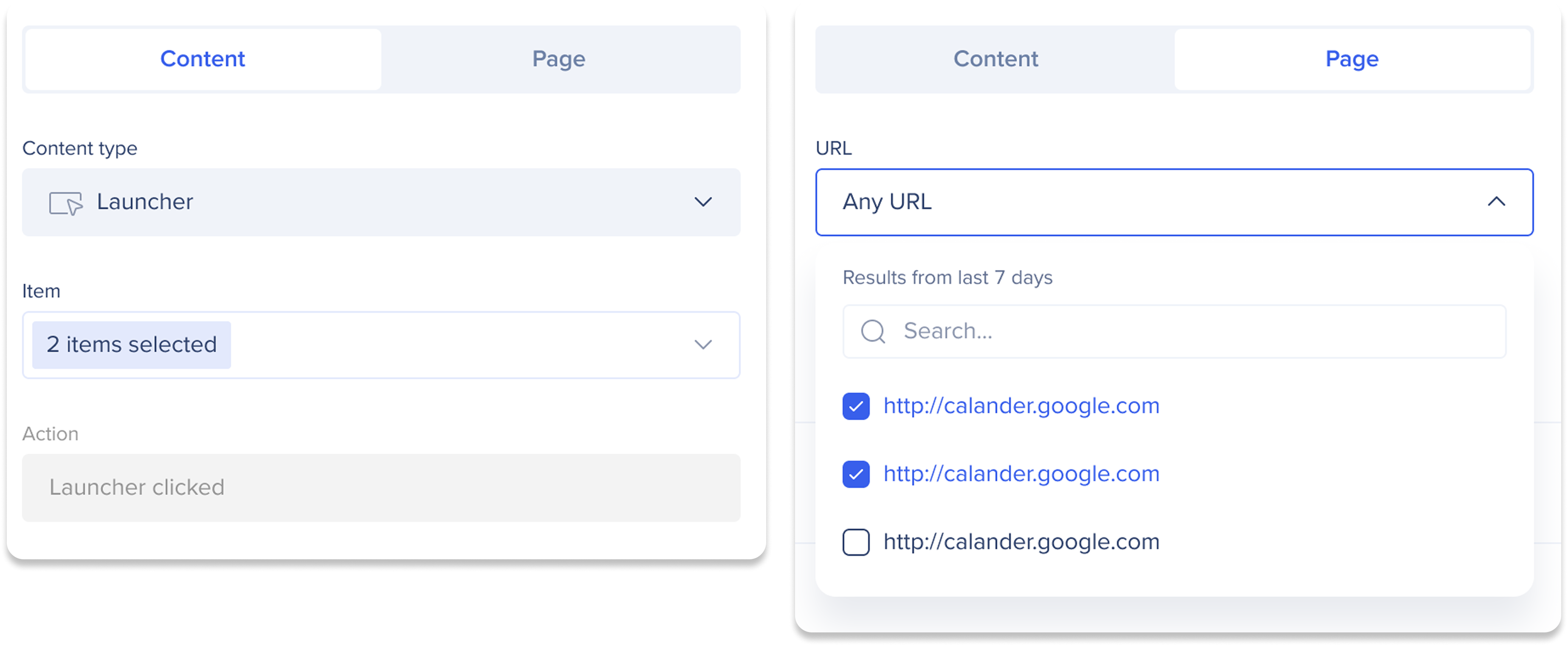
Click Events to select a Tracked Event or Engaged Element from your events list for this step.
Click the Select element dropdown
Select either a Tracked Event or Engaged Elements
Click Apply
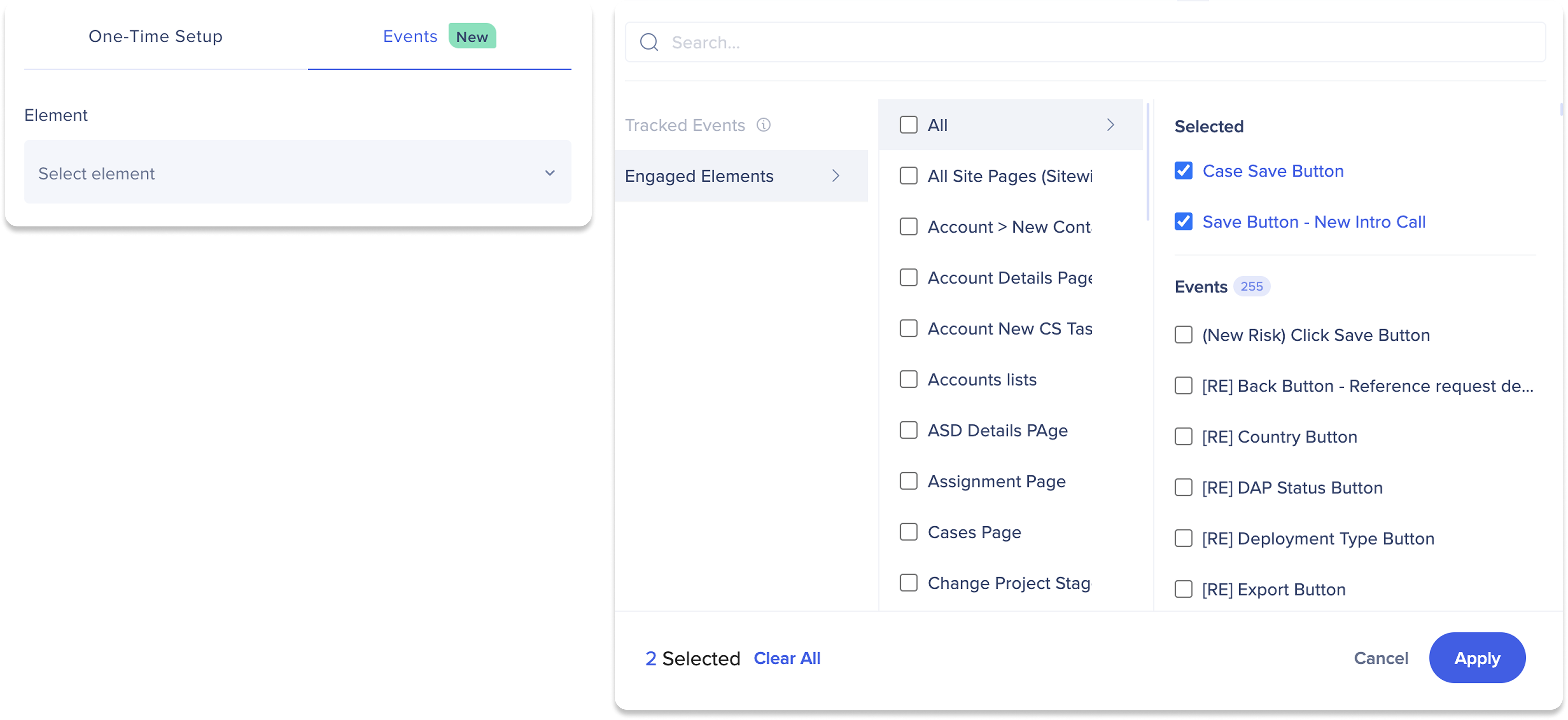
If needed, add filters to your step
Click the Filters Plus button +
Select a property from category or WalkMe Content to filter by
Choose a rule to filter by (ex: is equal, is not equal)
Select values
(if required) Type the value manually in the Search field and select Specify
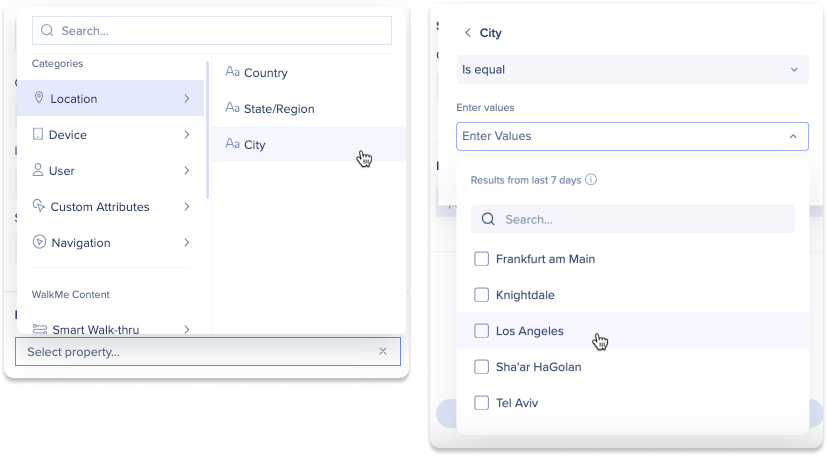
11. Click Calculate to add it to your funnel/path

Once you add more than one step, you can apply conditions, or constraints according to which data is calculated, you would like between your steps
Click the right arrow to add a conditions between your steps
Click + Add Condition to add multiple conditions

15. Once you have defined a step, you will see your flow calculate
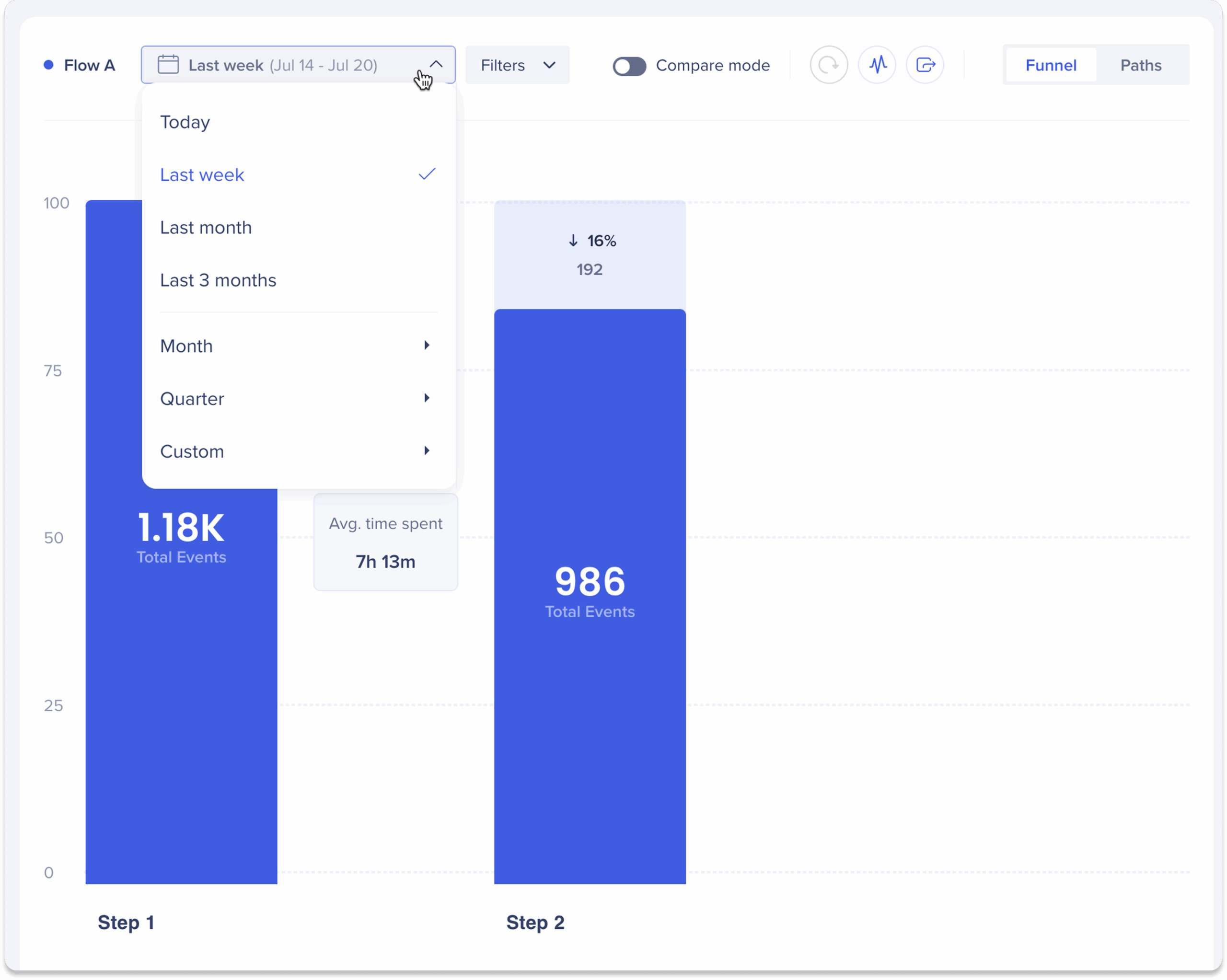
Click Save to save your work
If you don't save before existing, a popup screen will appear
How to delete a step
Select the step you'd like to delete
Click the trash icon
How to duplicate a step
Select the step you'd like to duplicate
Click the duplicate icon
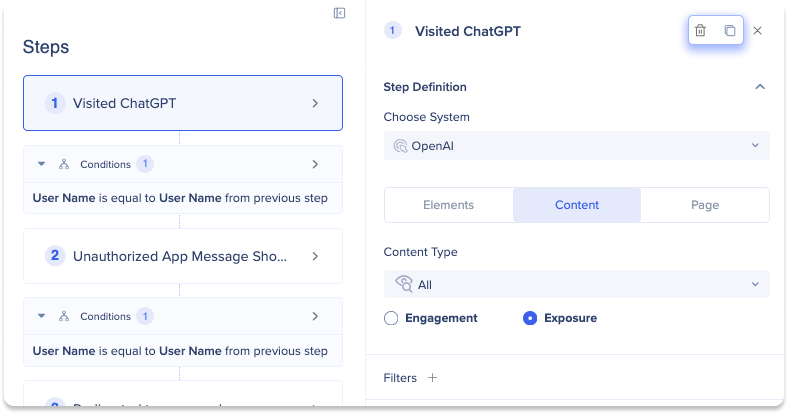
To dive deeper into your events, you can utilize the Analytics Menus. These menu offers different options that can help you identify the most and least successful paths and analyze completion rates and user paths. The options are as follows:
On Funnel View
Visualize: This option enables you to view and analyze your data in a deeper, more detailed way
Show Data as: You can use this option to select a specific property and view data according to that property

On Paths View
Visualize: This option enables you to view and analyze your data in a deeper, more detailed way
Split by: This options allows you to split a data by a property in the Paths view
Add to filters: After using the Split by function, this option allows you to select a segment in the split and make that segment the be only result shown in the chart
Exclude from results: After using the Split by function, this option allows you to select a segment in the split to exclude from the results shown in the chart
Number of buckets: This option allows you to choose how many groups you would like to view when using the Split By function (not in the click bar menu, this appears as a dropdown over the event bars)
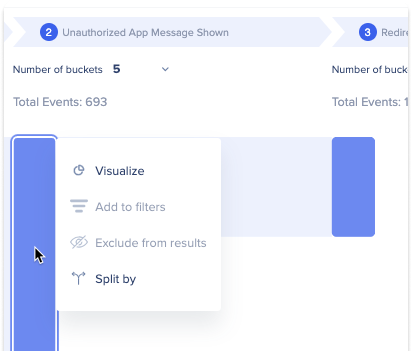
Visualize allows you to gain a deeper understanding of your data by presenting it in an easily digestible format. With Visualize, you can view your data in graph form and apply filters to display only the data you need to see.
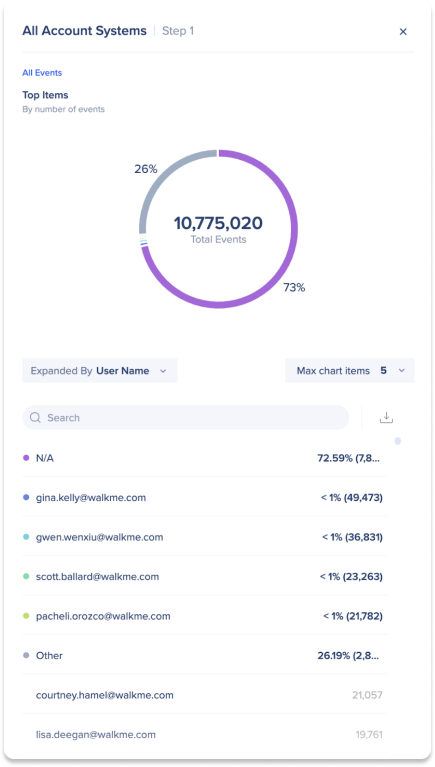
Click the bar in the chart area that relates to the step
Select Visualize
A side panel will open
Use the dropdown to view specific data. Here are your options:
Expand by a different property (ex: Location, Device etc..)
Change number of chart items
Click a specific item and deep dive further
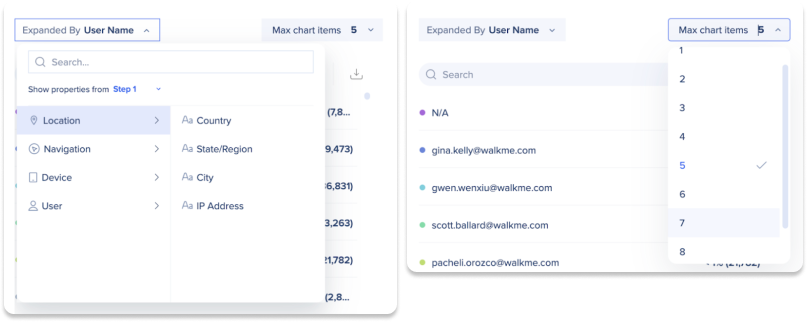
Show data as enables you to select a particular property and analyze your data based on that property. This means you can analyze your data not just by events, but also by other factors such as "Country" or "Browser". This can be particularly helpful when trying to identify specific issues within an event, rather than analyzing the event as a whole.
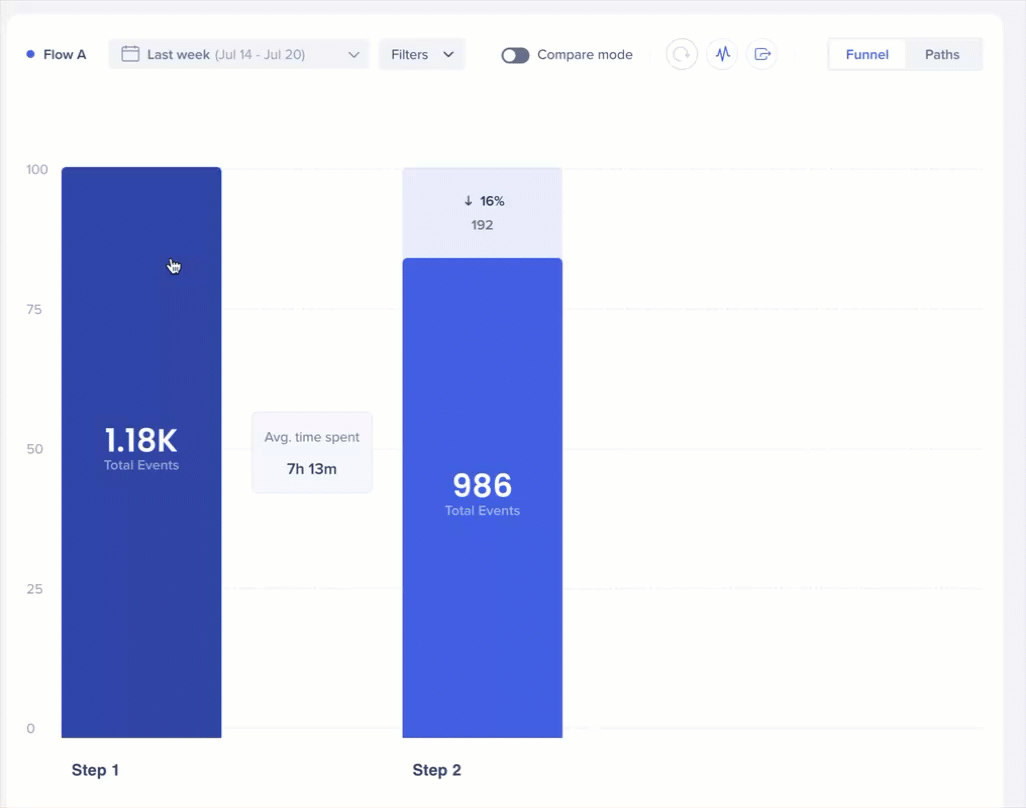
Click Apply to see data for the bar you selected, or Apply to All to see for the entire Workflow.
Click the bar in the chart area that relates to the step
Select Show data as
Select the property you would like to show
Now events will be grouped according to a unique count of that property
Example: If you had 10k events from three different countries and you want to display the data by country, the count will show as three
Split by enables you to segment data based on a property in the Paths view. This allows you to analyze data for each step based on additional factors such as "Country" or "Browser" ., and view the results into under that step.
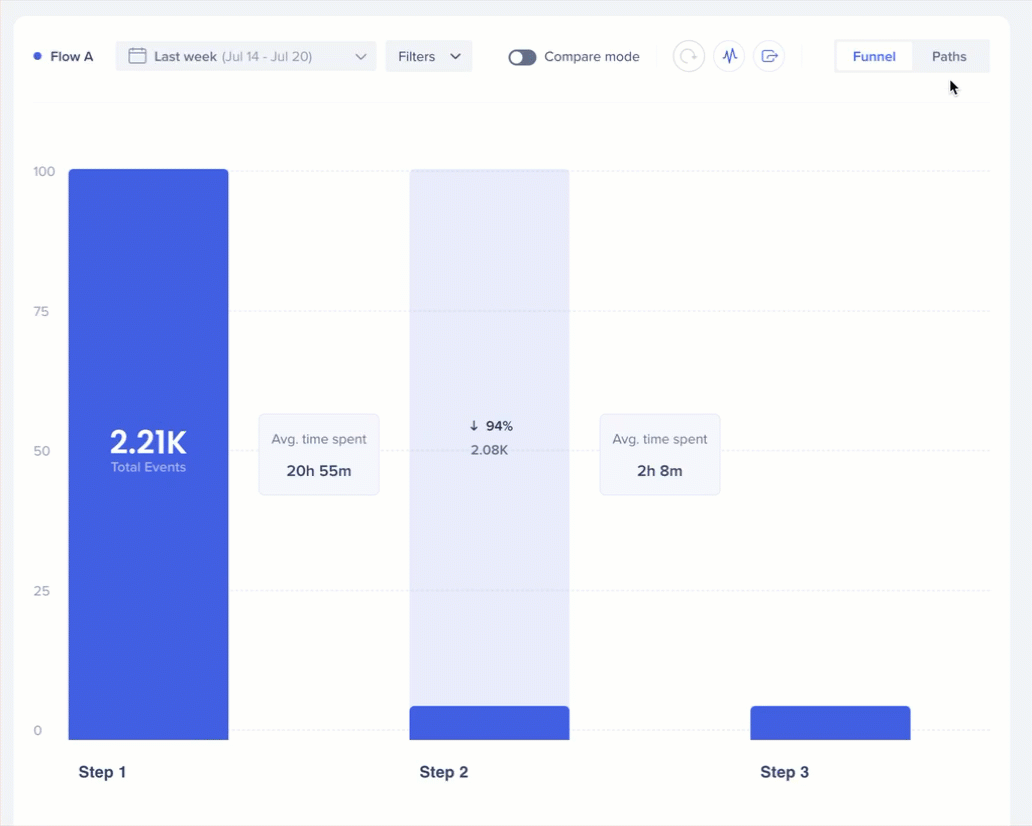
Select Paths Toggle
Click the bar in the chart area that relates to the step you want to split
Select Split by
Choose which property you would like to split by
To undo a split
Click any split part of the bar
Select Regroup
After using the Split by function, this option allows you to select a segment in the split and make that segment the be only result shown in the chart.
Select Paths Toggle
Click the bar in the chart area that relates to the step you want to add to filters
Pre-condition: The bar must already be split by a property
Select Add to filters
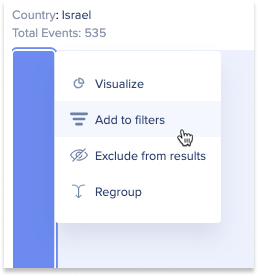
After using the Split by function, this option allows you to select a segment in the split to exclude from the results shown in the chart.
Select Paths Toggle
Click the bar in the chart area that relates to the step you want to exclude from results
Pre-condition: The bar must already be split by a property
Select Exclude from results
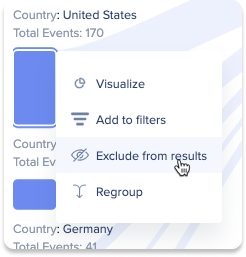
This option allows you to choose how many groups you would like to view when using the Split By function (not in the click bar menu, this appears as a dropdown over the event bars)
Select Paths Toggle
Click the Number of buckets dropdown
Pre-condition: The bar must already be split by a property
Select the number of buckets you would like to see
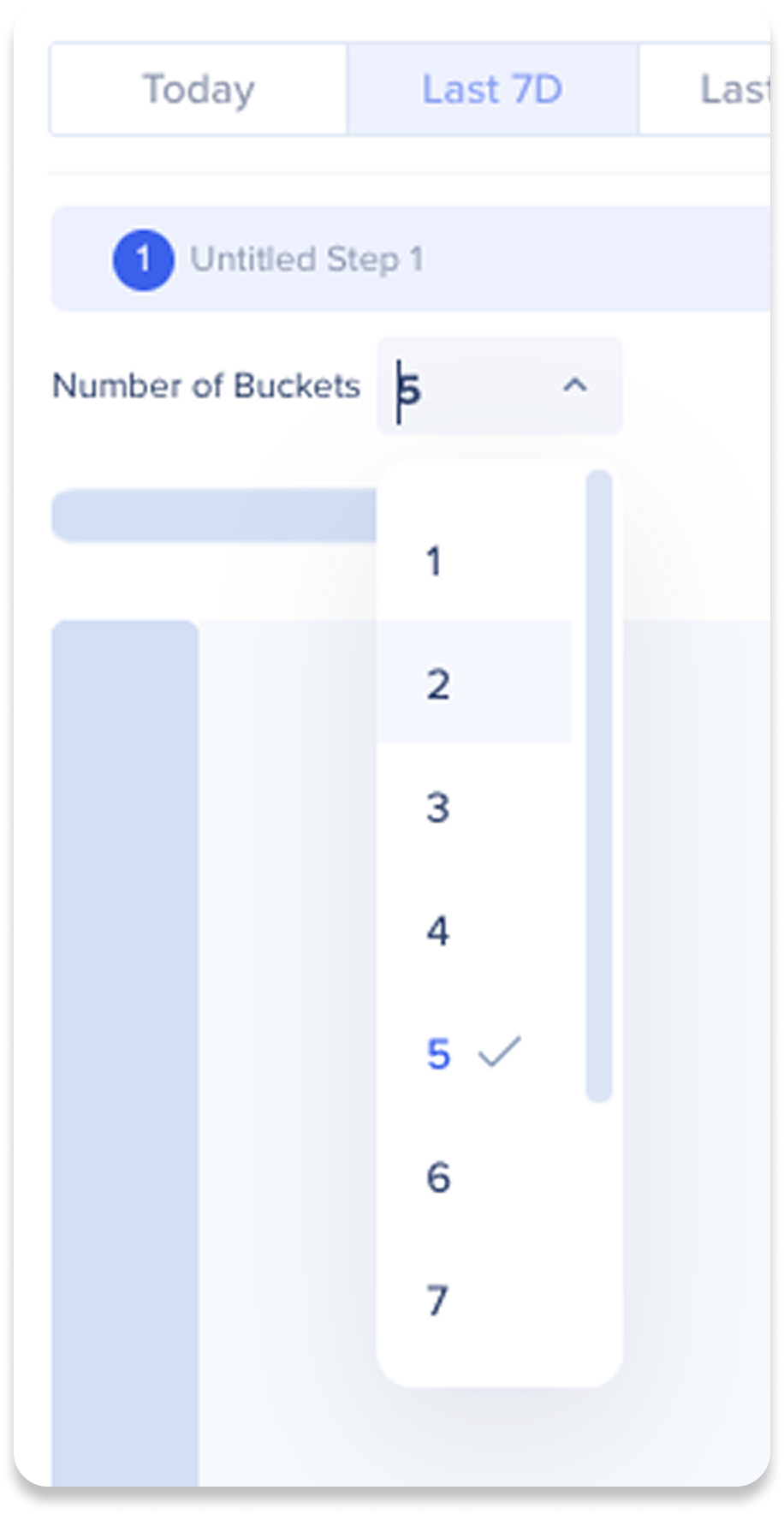
Export comprehensive, user-level flow data as a report for deeper analysis, seeing each step, duration, and completion across the entire funnel.
How it works
Click the Export icon
Choose Flow Report by User ID
The report will appear in the Exports & Subscriptions page in Insights

Steps must be completed in order
We don't count actions per session
Steps don't have to occur immediately one after another
If a user does a step multiple times: we only count the first step that occurs after the previous one
What is Flow Comparison?
Flow comparison allows you to compare the same flow using different:
Date ranges
Filters
The comparison is displayed side-by-side, showing key statistics for both versions of the flow (Flow A and Flow B), so you can identify differences in behavior.
In the Flow header, turn on the Compare mode toggle
You'll now see two panels: Flow A (your original flow) and an empty Flow B
In Flow B, set a different date range, apply a saved filter, or both
![]() Click the Calculate icon to load results
Click the Calculate icon to load results
If you change filters or date range after calculating, you'll need to click Calculate again
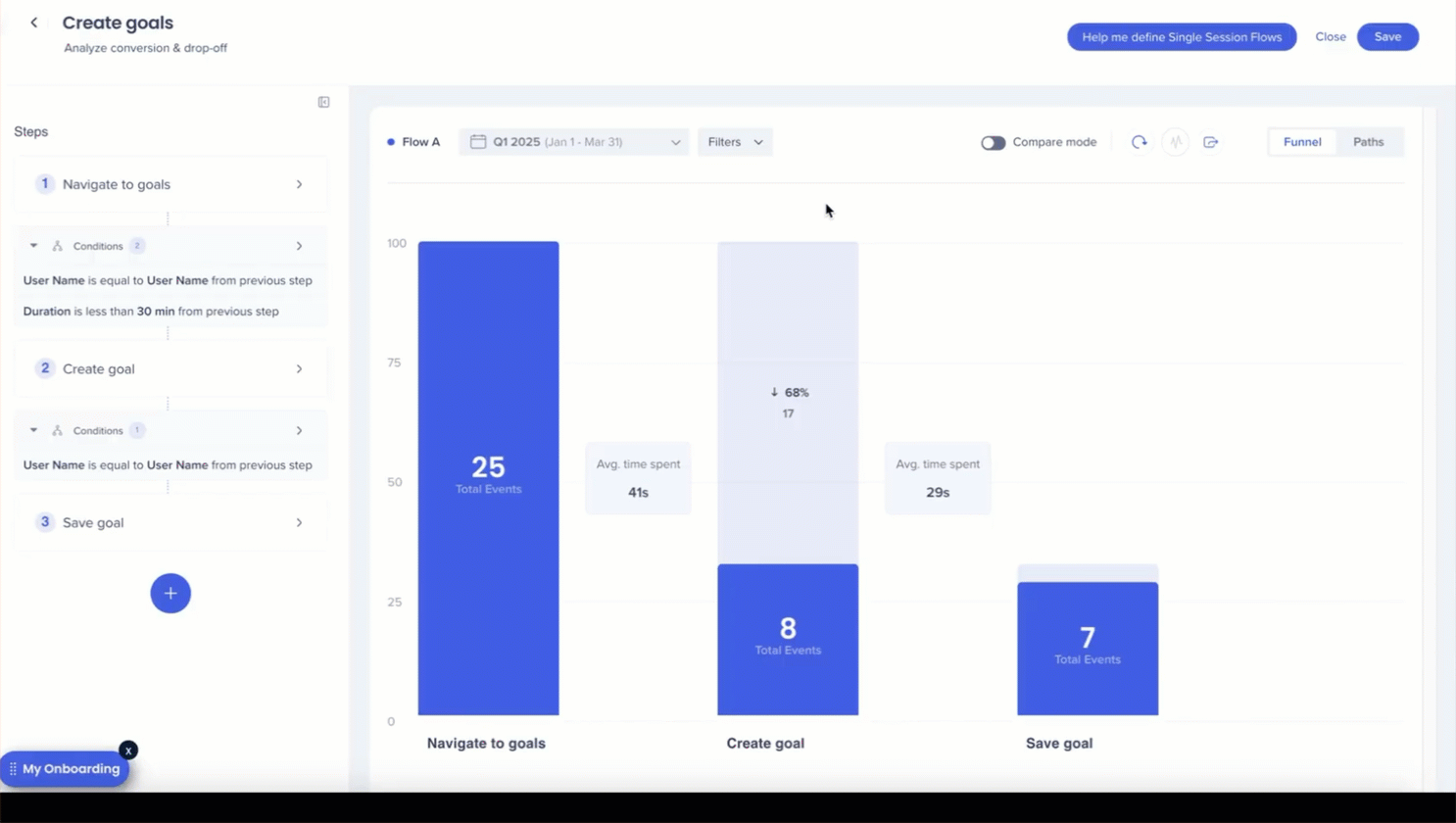
In Compare mode, each step in the funnel displays results for both Flow A (Blue) and Flow B (Orange) side-by-side. For each flow, you'll see:
Total Events: The number of times users completed the step
Drop-off Percentage: The percentage decrease in users compared to the previous step
Average Time Spent: The average duration between steps
When you hover over any step, you can:
Click Visualize to open a side panel showing a detailed breakdown for that specific flow and step
Use Show data as to segment results by properties such as browser, location, or department — helping you analyze differences between user groups

![]() Click the Statistics icon in the flow header to open the Flow Statistics popup, which provides a detailed summary of flow performance metrics, available for both Flow A and Flow B when Compare Mode is on.
Click the Statistics icon in the flow header to open the Flow Statistics popup, which provides a detailed summary of flow performance metrics, available for both Flow A and Flow B when Compare Mode is on.
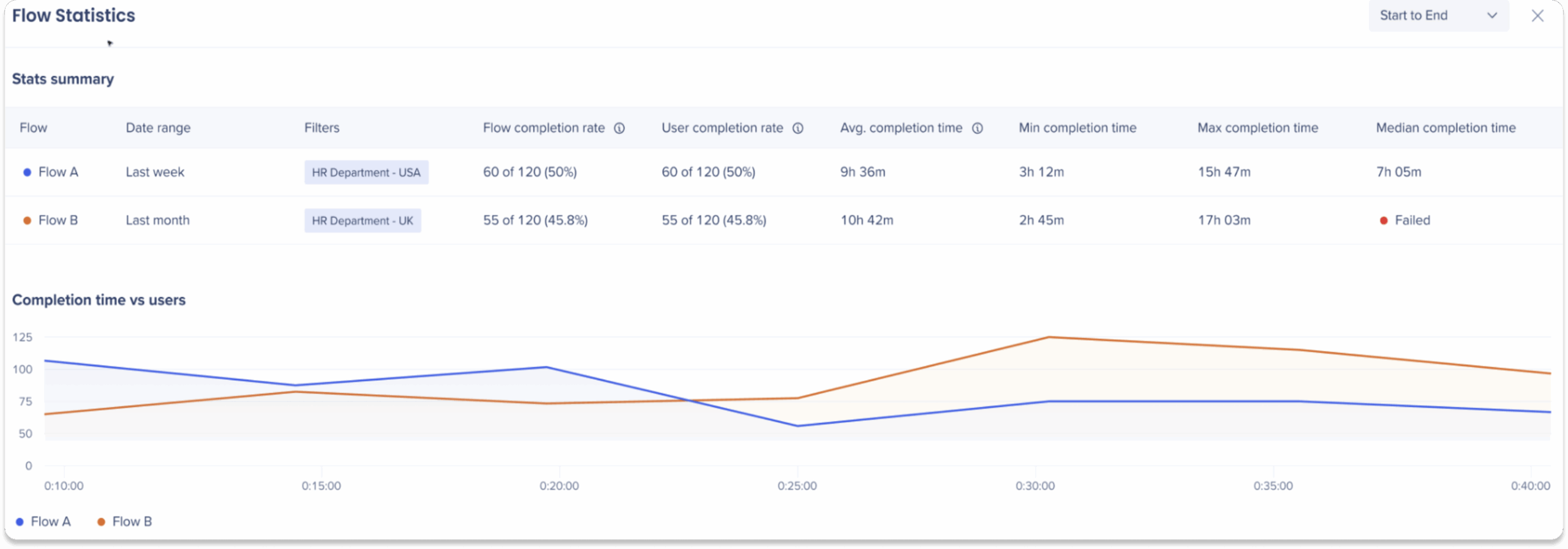
Stats Summary
At the top of the popup, you'll see a Stats summary table with the following metrics:
|
Metric |
Description |
Real-Life Example |
|---|---|---|
|
Flow completion rate |
Measures how many times users completed the last step in the selected range, compared to how many times the first step was triggered.
|
Flow: Add to Basket → Check-out
That's:
Flow completion rate = 1 / 6 = 17% This helps you measure how many total attempts reach the end, even if the same user contributes multiple times. |
|
User completion rate |
Measures how many users completed the last step in the selected range at least once, compared to how many unique users triggered the first step.
|
Flow: Add to Basket → Check-out
That's:
User completion rate = 1 / 2 = 50% This helps you understand how many people are successfully completing the process, no matter how many times they tried. |
|
Average completion time |
Measures the average time it takes to go from the first step to the last step in the selected range.
|
Flow: Add to Basket → Check-out
Only User A will be counted. Average completion time = 1h / 1 = 1h This shows how long it typically takes users who complete the flow. |
|
Min / Max completion time |
Shows the fastest and slowest times it took any user to complete the selected step range.
|
Flow: Add to Basket → Check-out
Min = 2h, Max = 5h Use this to spot outliers or large timing gaps. |
|
Median completion time |
Shows the midpoint of all valid completion times. Half of completions were faster and half were slower.
|
Flow: Add to Basket → Check-out
Median = (2h + 3h) / 2 = 2.5h Helps you understand the typical user experience without being skewed by outliers. |
Completion Time vs Users Chart
Below the summary table is a line chart showing Completion Time vs. Number of Users for each flow:
X-axis = Completion time intervals
Y-axis = Number of users who completed the flow in that time window
This helps you spot completion trends, outliers, or bottlenecks between audiences.
Flow Comparison includes a set of out-of-the-box (OOTB) pre-built filters that help you analyze how users who were exposed to or interacted with WalkMe content behave differently from those who weren't. These filters apply across the entire selected time range, not individual sessions.
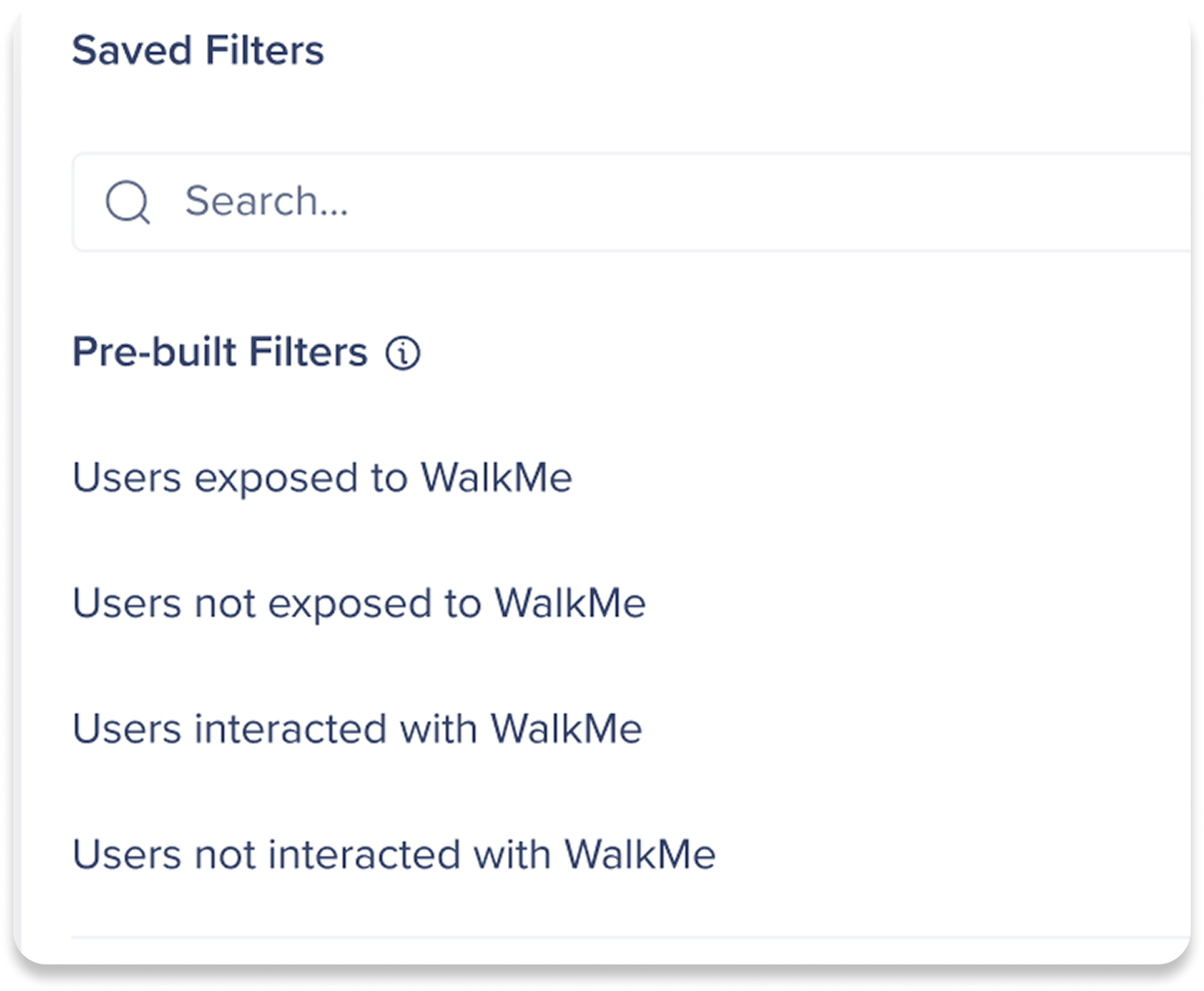
Users who had at least one WalkMe item visible or available to them (with any segmentation and rules applied) in the selected time range.
Real-life example:
Scenario
You're analyzing a flow in Gsuite that starts with the step “Visited Google Calendar”, with a selected date range of Monday to Friday
A ShoutOut was show to the user on Monday
A user visits Google Calendar on Tuesday
Analysis
Even though the ShoutOut appeared on a different day, the user is still counted as Exposed to WalkMe because the exposure and the step both happened within the selected time range
Users who did not have any WalkMe item visible or available to them (with any segmentation and rules applied) in the selected time range.
Real-life example:
Scenario
You're analyzing a flow in Gsuite that starts with the step “Visited Google Calendar”, with a selected date range of Monday to Friday
A user visits Google Calendar on Wednesday
No WalkMe content was triggered, displayed, or available to them at any time that week
Analysis
This user is counted as Not Exposed to WalkMe as no steps contain WalkMe content, and no context was deployed on the Google Calendar page
Users who engaged with at least one WalkMe item (e.g., clicked a Launcher, played a Smart Walk-Thru, etc.) in the selected time range.
Real-life example:
Scenario
You've deployed a Launcher in Gsuite that links to a phishing awareness flow. The flow begins with the step “Clicked Phishing Alert Launcher”, with a selected date range of Monday to Friday
On Wednesday, a user clicks the Launcher
On Friday, they complete the next step in the flow by completing a security checklist
Analysis
This user is counted as Interacted with WalkMe since they actively clicked the Launcher within the selected date range
Real-life example:
Scenario
You're analyzing a phishing awareness flow in Gsuite over a one-week range
A user sees the ShoutOut on Monday, but doesn't click it
On Tuesday, they visit Google Calendar and proceed through the rest of the flow
Analysis
This user is counted as Not Interacted with WalkMe because while WalkMe content was visible, the user did not take any action on it
If your flow has a step that tracks WalkMe engagement, like clicking a Launcher, using the filters "Not Exposed" or "Not Interacted" will show zero results.
Example
Step: Clicked Launcher
Filter: Not Exposed to WalkMe
Analysis
This user can't be both not exposed and actively engaged
Only use these filters in flows where WalkMe content is not part of the steps
Filters apply to any WalkMe content — not a specific ShoutOut, Launcher, or Smart Walk-Thru.
Recommendation
Add the specific WalkMe item as a step in your flow, such as "ShoutOut shown"
Then, apply a general exposure or interaction filter
Note that you cannot use "not exposed" or "not interacted" for this purpose
Pre-built filters are applied across the entire selected time range, not per session like in Insights Classic. This means users are included if they were exposed to or interacted with WalkMe at any point during the date range, even if that happened before or after the flow steps.
Scenario 1
Flow steps: Create goal → Save Goal
Time range selected: Monday → Friday (Marked in green in the tables)
Filter selected: User was exposed to WalkMe

Analysis: In this scenario, a user is counted as Exposed to WalkMe since they encountered the ShoutOut during the selected time range.
Unlike Classic Insights, this exposure isn't tied to a specific session. The user doesn't need to view the ShoutOut on the same day as the flow step create / save goal; it just needs to occur within the chosen period.
So even if the shoutout was viewed before or after the flow steps, it will be counted as Exposed to WalkMe as long as it's in the selected time range
Scenario 2
Flow steps: Create goal → Save Goal
Time range selected: Monday → Friday (In time range marked in green / Out of time range marked in red)
Filter selected: User Not Exposed to WalkMe

Analysis: In this scenario, a user is counted as Not Exposed to WalkMe since they did not encountered the ShoutOut during the selected time range.
So even if a user saw a ShoutOut at any time during the year but not during the selected time period, they will be counted as Not Exposed to WalkMe
Optimize Flow Analytics Performance
Flow Analytics is ideal for understanding specific flows or processes. Rendering speeds may increase when searching across more events.
Searching more Time/Systems/Users Steps/Content/Pages/Elements can lead to longer loading times
For systems with thousands of users, the request may exceed the 60-second time limit and cause the page to timeout
In such cases, we recommend restricting the number of events by adding filters and reducing the number of steps, systems, or the timeframe
WalkMe must be deployed via Extension or Snippet
DeepUI is a prerequisite for using Engaged Elements
Engaged Elements must be created in the WalkMe Editor
For Cross app tracking, the user ID must be similar when tracking user behavior cross app
Must have access to a System to view a flow that contains that System
To support Page view tracking, the user needs to have Page view collection or full DXA enabled
10 steps maximum are supported in a funnel (need more? we'd love to hear more use cases to support this requirement.)
Maximum 5 conditions between steps
Maximum 5 filters per step
No session playback of funnels
No custom attributes from Engaged Elements
No more single session vs multi session
Existing Funnels will not be ported over
Number of buckets is limited to 10
Desktop/Mobile systems aren't supported
Session playback isn't supported
Mobile web data isn't supported
| Insights Classic Funnels | Flow Analytics | |
| Multi-system support | Steps Limited to only one system | Steps can traverse multiple systems |
| # of steps | 5 | 10 |
| Conditions between steps | Not available | Can set conditions for users between steps e.g only care users who completed the previous step within 5 minutes of the last one. |
| Management | Not available, just one long list | Can see who created, modified and has access to your flows. |
| Path support | Not available | See how users move through multiple paths to get to their destination. |
| Step filtering | Not available | Filter a specific step. Only want the users based in USA or who used Chrome. Now you can. |
| Step data deep dive | Not available | Now you can dig into a specific step and deep dive into the data to understand what's really happening. (Select an item from the graph and click Visualize) |
| All system, Engaged Element or content | Not available, have to select a specific item | Can now see All the engaged elements or content to get a high level view of all your WalkMe content. |
| Export | Not available | Quickly export a PNG of the graph so you can tell the WalkMe value story. |
| Non user tracking Beta | Not available | Allows the tracking of a non user object through multiple systems e.g a support ticket that moves from service now to Jira to salesforce can now be tracked. |
| Tracking for all events | Not available, tracks unique users rather than all events. This means that if a user triggers an event multiple times in a session, it will only be counted once. | Allows tracking for all events and not just for unique users. |
| Customer defined sessions | Session defined by WalkMe (For example, 12 hours maximum or ends after a 30 minute period of inactivity) | Customers can define a duration condition to define a session as they wish |